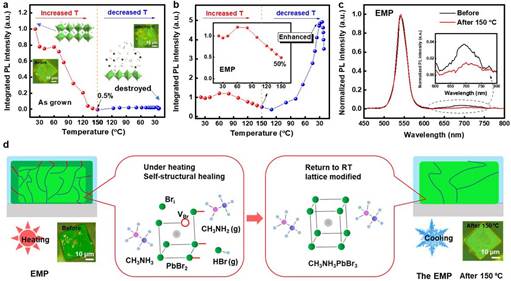On March 31, Dr. Li Bobo, associate researcher of the College of New Materials and New Energies, Shenzhen Technology University (SZTU), published a research article titled “Self-Structural Healing of Encapsulated Perovskite Microcrystals for Improved Optical and Thermal Stability” in the renowned international journal Advanced Materials (JCR Quartile: Q1; Impact Factor: 27.398) as the co-first author. The journal has been bringing the latest progress in materials science every week for over 30 years. The research was done in collaboration with other researchers from Southern University of Science and Technology, Guangxi University of Science and Technology, and State Key Laboratory of High Power Semiconductor Lasers of Changchun University of Science and Technology. The full text of the article can be found at: https://onlinelibrary.wiley.com/doi/10.1002/adma.202100466.

The cover of Advanced Materials [Photo/ https://onlinelibrary.wiley.com/]
As an emerging kind of semiconductor materials for laser gain, organic-inorganic metal halide perovskites have attracted intensive attention in recent years due to their features including high gain coefficient, tunable direct band gaps, broad spectral range and affordable price. However, the fact that the stability of perovskites can be easily affected by temperature, light irradiation, humidity and oxygen has been the principal limitation on their application in optoelectronic devices. Faced with the intrinsic deep level trap states (DLTS) caused by surface dangling bonds and grain boundaries, Dr. Li Bobo and her collaborators encapsulate the CH3NH3PbBr3 (MAPbBr3) perovskite microcrystal in a dense Al2O3 layer to form a microenvironment. After thermal treatment on the microcrystal, the photoluminescence (PL) intensity decreases quickly with temperature increasing from room temperature (RT) to 150 °C and then increases when the temperature cools down from 150°C to RT, which is resulted by the reduction of DLTS density with changing temperatures according to their analysis. The study finds that the encapsulated MAPbBr3 perovskite (EMP) sample is able to maintain high crystal quality at 250°C and the crystal structure will be re-grown after annealing at 150 °C, which provides an effective way to obtain high-quality perovskites with good stability.

Mechanism of self-structural healing of the EMP sample [Photo/ https://onlinelibrary.wiley.com/]
Drafted by Olivia(赖丽伟)/ International Cooperation & Student Affairs Office
Edited by International Cooperation & Student Affairs Office
